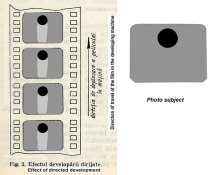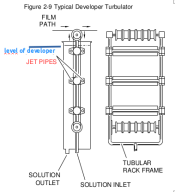georgegrosu
Member
Lately, I have seen several posts where various malfunctions (star, darker spots) are discussed for various films.
I am going to present same information about the faults I know when processing of films and which may be useful for some.
For the word "zoneje" I did not find a translation.
Agitation of the developer solution.
Kinetics of the development process depends largely on the speed of diffusion of substances is made (ie ions) from solution of developer to the emulsion of film and the products of reactions from emulsion go to out.
Besides of diffusion direction : developer - emulsion – developer, It takes place an internal diffusion inside of the emulsion, causing an interaction between neighboring areas of the image that received different exposures and between layers of color films.
The rate of diffusion of substances depend on the solution temperature and the distance they have to go.
Exchange of substances between emulsion and outdoor hindered by an adherent layer of developer on the surface of emulsion film, that has a different chemical composition than the rest of the developer. Adherent layer of developer is poorer in active substances of developer and richer in the development products (oxidised). If the diffusion process is slowed down or accelerated from this adherent layer, or other causes, there are some defects in development which is manifested by unevenness of density in areas that have received the same exposure.
The main defects of development are as follows:
- the effect of developer directed;
- zonajele (no english translate) ?;
- marginal effects (adjacency).
Effect of developer directed occurs - as shown in Figure 2 - by under developing areas (lower density) behind some image detail that received huge exposure. Because transporting film (agitation), the products of developer (bromine ions, oxidizing substances, etc.) results in an area with high exposure to developing intense and go down through the adherent layer and slows diffusion and film development in the surrounding area. Zonajele (see Fig. 3) are some unevenness of density in the vertical direction, visible only on the screen (displacement of images), which light travels to the side. Is due to the fact the developer adheres more easily and dripping down mainly on certain portions of the surface of the emulsion, which over developer. These defects, which is seen better on lower densities occupying large areas in the image (ie the sky), are all the more powerful as the development airline (sometimes without developer) is longest.
The effects of the adjacency, which are presented in Figure 4 the effect of the border, the effect EberJiard represents unevenness of density that forms the boundary of separation of areas with different exposure, due to anomalies in the conduct diffusion of substances that occur within the emulsion in during development. To liquidate or reduce defects above, it is necessary to intensify the diffusion process, which is done by reducing the thickness of developer adhering to the surface of the emulsion. By strong agitation of the developer can eliminate the routing development and severe reduction of zonajelor and marginal effects. When developed industrial agitation of developer, is done in two ways: general agitation and local agitation.
• The physical state of the developer. During the development process, the developer solution is gradually contaminate due to the following main reasons:
- the formation of insoluble organic compounds;
- accumulation of metallic silver;
- impurification of developer by the film.
Insoluble organic compounds are formed by polymerization of oxidation products of developer substances (eg quinone) resulting from the reaction developed or oxidation. These organic compounds forming a precipitate in suspension, reddish-brown, it accumulates with time particularly in developer with low sodium sulfite concentration, such as chromogenic developer.
Metallic silver resulting from the reduction of silver ions (Ag +) in solution of existing developer substances. Silver ions that come from partial dissolution, in a small proportion, the photosensitive silver halide crystals by sodium sulfite existing in developer. Therefore, developer containing high sulfite concentration (eg for developer black and white for negative film) impurification with metallic silver an extent most significant developer than the others developer.
The film transport and introduce permanent in developer powder of support and emulsion remained from cutting and perforation operations at the factory. To this we add small amounts of gelatin that are separating from the emulsion due to friction conveyor rollers of the processing machine of film. Gelatin particles remain in suspension is lighter and other impurities formed by embedding so-called ,, slime” that adhere easily on film surfaces, especially emulsion.
Impurities that accumulate are deposited on pipe walls, which reduces solution circulation and thus the degree of agitation of the developer. In addition, some substances can stain or dirty emulsion film.
Because the process of development to take place in good conditions, it is necessary that the developer solution be cleaned by removing impurities.
Cleaning the developer, and other solutions, surgery is typically performed by filtration.
George
I am going to present same information about the faults I know when processing of films and which may be useful for some.
For the word "zoneje" I did not find a translation.
Agitation of the developer solution.
Kinetics of the development process depends largely on the speed of diffusion of substances is made (ie ions) from solution of developer to the emulsion of film and the products of reactions from emulsion go to out.
Besides of diffusion direction : developer - emulsion – developer, It takes place an internal diffusion inside of the emulsion, causing an interaction between neighboring areas of the image that received different exposures and between layers of color films.
The rate of diffusion of substances depend on the solution temperature and the distance they have to go.
Exchange of substances between emulsion and outdoor hindered by an adherent layer of developer on the surface of emulsion film, that has a different chemical composition than the rest of the developer. Adherent layer of developer is poorer in active substances of developer and richer in the development products (oxidised). If the diffusion process is slowed down or accelerated from this adherent layer, or other causes, there are some defects in development which is manifested by unevenness of density in areas that have received the same exposure.
The main defects of development are as follows:
- the effect of developer directed;
- zonajele (no english translate) ?;
- marginal effects (adjacency).
Effect of developer directed occurs - as shown in Figure 2 - by under developing areas (lower density) behind some image detail that received huge exposure. Because transporting film (agitation), the products of developer (bromine ions, oxidizing substances, etc.) results in an area with high exposure to developing intense and go down through the adherent layer and slows diffusion and film development in the surrounding area. Zonajele (see Fig. 3) are some unevenness of density in the vertical direction, visible only on the screen (displacement of images), which light travels to the side. Is due to the fact the developer adheres more easily and dripping down mainly on certain portions of the surface of the emulsion, which over developer. These defects, which is seen better on lower densities occupying large areas in the image (ie the sky), are all the more powerful as the development airline (sometimes without developer) is longest.
The effects of the adjacency, which are presented in Figure 4 the effect of the border, the effect EberJiard represents unevenness of density that forms the boundary of separation of areas with different exposure, due to anomalies in the conduct diffusion of substances that occur within the emulsion in during development. To liquidate or reduce defects above, it is necessary to intensify the diffusion process, which is done by reducing the thickness of developer adhering to the surface of the emulsion. By strong agitation of the developer can eliminate the routing development and severe reduction of zonajelor and marginal effects. When developed industrial agitation of developer, is done in two ways: general agitation and local agitation.
• The physical state of the developer. During the development process, the developer solution is gradually contaminate due to the following main reasons:
- the formation of insoluble organic compounds;
- accumulation of metallic silver;
- impurification of developer by the film.
Insoluble organic compounds are formed by polymerization of oxidation products of developer substances (eg quinone) resulting from the reaction developed or oxidation. These organic compounds forming a precipitate in suspension, reddish-brown, it accumulates with time particularly in developer with low sodium sulfite concentration, such as chromogenic developer.
Metallic silver resulting from the reduction of silver ions (Ag +) in solution of existing developer substances. Silver ions that come from partial dissolution, in a small proportion, the photosensitive silver halide crystals by sodium sulfite existing in developer. Therefore, developer containing high sulfite concentration (eg for developer black and white for negative film) impurification with metallic silver an extent most significant developer than the others developer.
The film transport and introduce permanent in developer powder of support and emulsion remained from cutting and perforation operations at the factory. To this we add small amounts of gelatin that are separating from the emulsion due to friction conveyor rollers of the processing machine of film. Gelatin particles remain in suspension is lighter and other impurities formed by embedding so-called ,, slime” that adhere easily on film surfaces, especially emulsion.
Impurities that accumulate are deposited on pipe walls, which reduces solution circulation and thus the degree of agitation of the developer. In addition, some substances can stain or dirty emulsion film.
Because the process of development to take place in good conditions, it is necessary that the developer solution be cleaned by removing impurities.
Cleaning the developer, and other solutions, surgery is typically performed by filtration.
George















